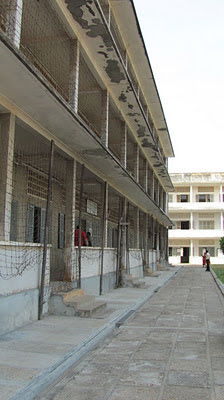After spending 3 days in Siem Reap, we left for the capital, Phnom Penh. The journey by road took about five hours with stops along the way. As soon as we entered the city, we were struck by how much more traffic there was on the streets, although the practice of driving slowly, something we noticed in Siem Reap, seemed to be a trend here also. Phnom Penh, with its bustling streets is a stark contrast to Siem Reap. Like any big city, it is a little grimier and a little edgier. Despite this, the city is quite charming and its French Colonial past is visible in the architecture of many of its buildings as well as the names of its streets and boulevards.
Independence monument celebrates Cambodia’s independence from foreign rule.
Our first stop in Phnom Penh was the Royal Palace. The lush and immaculately maintained gardens of the Palace grounds offer a calm oasis far removed from the noisy streets beyond the palace walls. The Royal Palace is a good example of Khmer architecture, and is a striking feature in the cityscape of Phnom Penh.
Entry to the Palace.
The Royal Throne Room.
The highlight of the Palace visit was the Silver Pagoda, so named for its silver tiled floor.
One of the buildings in the Palace complex that stands out because of its colonial style architecture.
 |
| Monks looking around the Palace grounds. |
In the evening, after an early dinner, we took a walk along the riverfront down Sisiwath Quay. This picturesque, park-lined street overlooks the confluence of the Tonle Sap, Mekong and Bassac rivers and houses numerous pubs and restaurants offering a wide variety of food and drink. It has a great atmosphere, especially in the evenings and we stopped off at one of the bars, a place called ‘Paddy Rice Irish Pub’ for a late night drink and some great apple pie.
Steps leading up to Wat Phnom.
Inside Wat Phnom.
On our second day in the capital, we visited Wat Phnom, a small hill crowned by a pagoda. This place marks the legendary founding place of Phnom Penh. From here we made our way to the Russian Market. The market is a great place to pick up some curios, silks and carvings. It also sells jewellery as well as VCDs, DVDs and CDs at great prices.
The Gallows at Tuol Sleng.
The exterior of the classrooms.
A monk in quiet contemplation at Tuol Sleng.
After a quick lunch we visited the Tuol Sleng genocide museum. Originally a high school, it was converted into the S-21 prison and interrogation centre under the Khmer Rouge regime. The buildings, which were originally classrooms, are housed behind high walls reinforced with barbed wire. As soon as you enter the place you get an eerie sense of the terror that must have gripped the men, women and children who were held here. It is difficult not to be deeply horrified as you go around the museum looking at wall upon wall of black and white photographs of the prisoners that were detained here during that time. You can also see the cells where the prisoners were housed. During this 4 year reign of terror it is estimated that 1.5 to 2 million people died. I have to warn you that a visit to this place is quite disturbing, but you simply must visit this place to understand and get a sense of what this country has been through and appreciate how they are slowly recovering.
The next day we rose early and made our way to Sihanoukville, for what would be the most relaxing part of our trip. More about this leg of our journey coming soon.
A small addition-
While waiting to fly out of Phnom Penh Airport, I came across a book by the name of ‘First They Killed My Father- a daughter of Cambodia remembers’, which I later got an opportunity to read. The book is basically a memoir of a young girl, Loung Ung, who endured life under the Khmer Rouge regime. Loung is now settled in the U.S and is a national spokesperson for the campaign for a Landmine Free World. This is an amazing book, where the story is told from the perspective of a child and I would recommend it for to anyone who wants to know more about Cambodia’s turbulent past.
[All images courtesy Shalini Pereira]











No comments:
Post a Comment